Supply Chain Resilience While Integrating Agile and Lean Strategy
VerifiedAdded on 2022/03/04
|21
|8802
|24
Report
AI Summary
This report delves into the critical importance of supply chain resilience in today's dynamic and complex business environment, exploring the impact of globalization, digitalization, and external factors such as the COVID-19 pandemic. It examines the challenges posed by supply chain disruptions, including internal issues, technical failures, and fluctuating customer demands, and highlights the role of agile and lean strategies in mitigating these risks. The report reviews the literature on supply chain management, emphasizing the benefits of integrating agile and lean techniques to enhance responsiveness, manage inventory, cut costs, and meet customer expectations. It also addresses national and global supply chain resilience, analyzing the impact of protectionist measures and government interventions, and proposing strategies for building robust and resilient supply chains. The report provides an in-depth study of contemporary issues, external forces, and the driving forces behind integrating lean and agile approaches in the supply chain, ultimately demonstrating how these strategies ensure resilience and boost overall organizational performance.
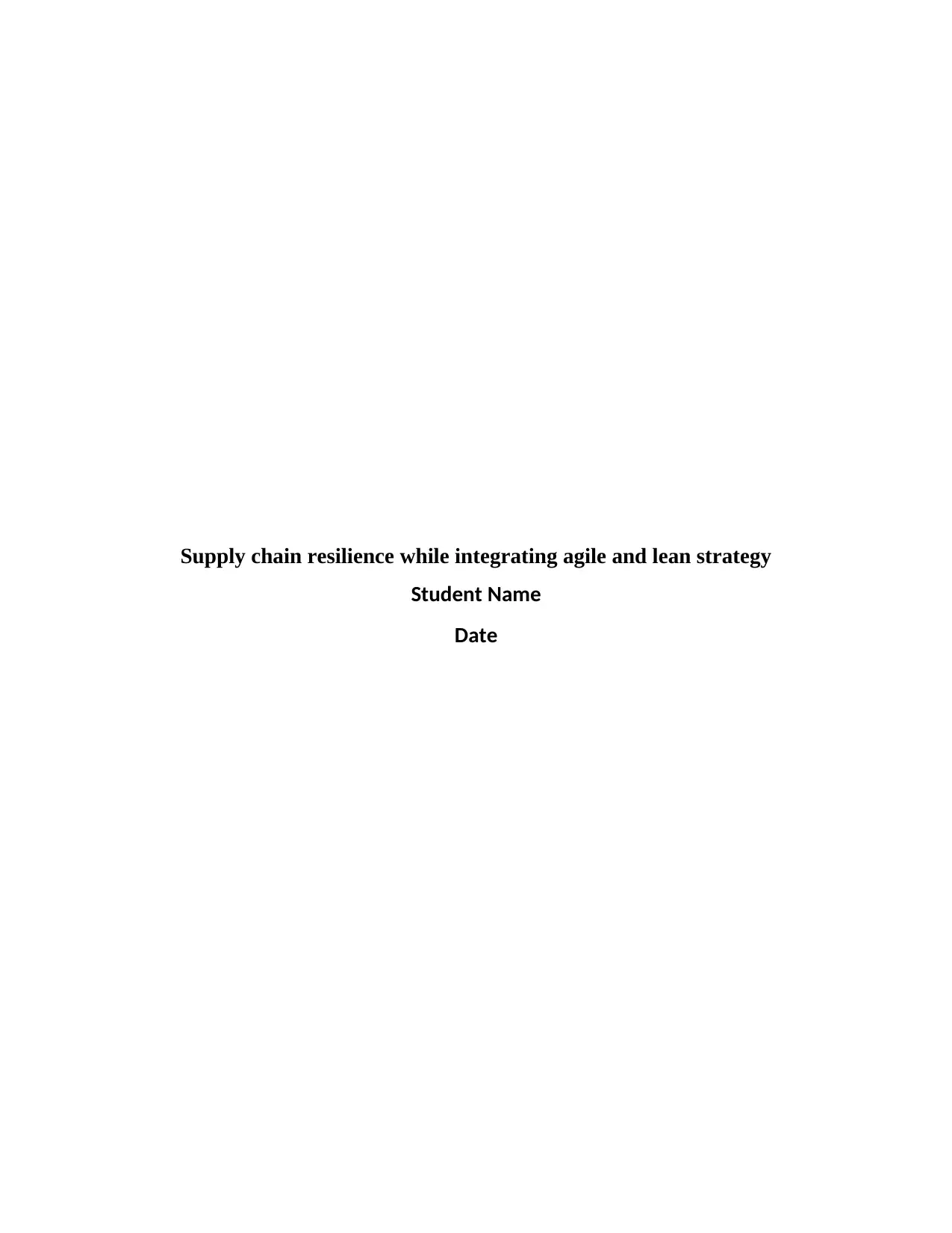
Supply chain resilience while integrating agile and lean strategy
Student Name
Date
Student Name
Date
Paraphrase This Document
Need a fresh take? Get an instant paraphrase of this document with our AI Paraphraser
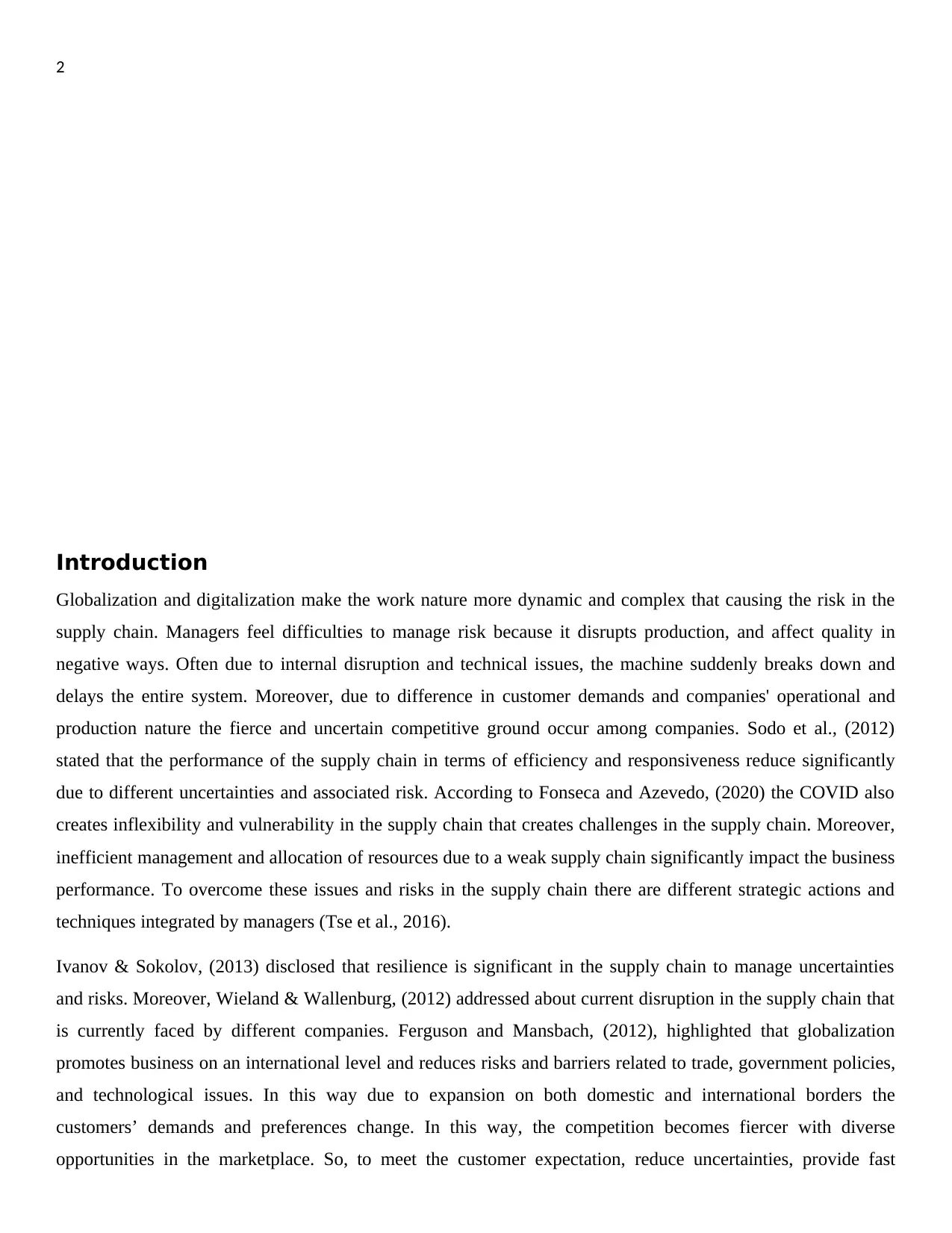
2
Introduction
Globalization and digitalization make the work nature more dynamic and complex that causing the risk in the
supply chain. Managers feel difficulties to manage risk because it disrupts production, and affect quality in
negative ways. Often due to internal disruption and technical issues, the machine suddenly breaks down and
delays the entire system. Moreover, due to difference in customer demands and companies' operational and
production nature the fierce and uncertain competitive ground occur among companies. Sodo et al., (2012)
stated that the performance of the supply chain in terms of efficiency and responsiveness reduce significantly
due to different uncertainties and associated risk. According to Fonseca and Azevedo, (2020) the COVID also
creates inflexibility and vulnerability in the supply chain that creates challenges in the supply chain. Moreover,
inefficient management and allocation of resources due to a weak supply chain significantly impact the business
performance. To overcome these issues and risks in the supply chain there are different strategic actions and
techniques integrated by managers (Tse et al., 2016).
Ivanov & Sokolov, (2013) disclosed that resilience is significant in the supply chain to manage uncertainties
and risks. Moreover, Wieland & Wallenburg, (2012) addressed about current disruption in the supply chain that
is currently faced by different companies. Ferguson and Mansbach, (2012), highlighted that globalization
promotes business on an international level and reduces risks and barriers related to trade, government policies,
and technological issues. In this way due to expansion on both domestic and international borders the
customers’ demands and preferences change. In this way, the competition becomes fiercer with diverse
opportunities in the marketplace. So, to meet the customer expectation, reduce uncertainties, provide fast
Introduction
Globalization and digitalization make the work nature more dynamic and complex that causing the risk in the
supply chain. Managers feel difficulties to manage risk because it disrupts production, and affect quality in
negative ways. Often due to internal disruption and technical issues, the machine suddenly breaks down and
delays the entire system. Moreover, due to difference in customer demands and companies' operational and
production nature the fierce and uncertain competitive ground occur among companies. Sodo et al., (2012)
stated that the performance of the supply chain in terms of efficiency and responsiveness reduce significantly
due to different uncertainties and associated risk. According to Fonseca and Azevedo, (2020) the COVID also
creates inflexibility and vulnerability in the supply chain that creates challenges in the supply chain. Moreover,
inefficient management and allocation of resources due to a weak supply chain significantly impact the business
performance. To overcome these issues and risks in the supply chain there are different strategic actions and
techniques integrated by managers (Tse et al., 2016).
Ivanov & Sokolov, (2013) disclosed that resilience is significant in the supply chain to manage uncertainties
and risks. Moreover, Wieland & Wallenburg, (2012) addressed about current disruption in the supply chain that
is currently faced by different companies. Ferguson and Mansbach, (2012), highlighted that globalization
promotes business on an international level and reduces risks and barriers related to trade, government policies,
and technological issues. In this way due to expansion on both domestic and international borders the
customers’ demands and preferences change. In this way, the competition becomes fiercer with diverse
opportunities in the marketplace. So, to meet the customer expectation, reduce uncertainties, provide fast
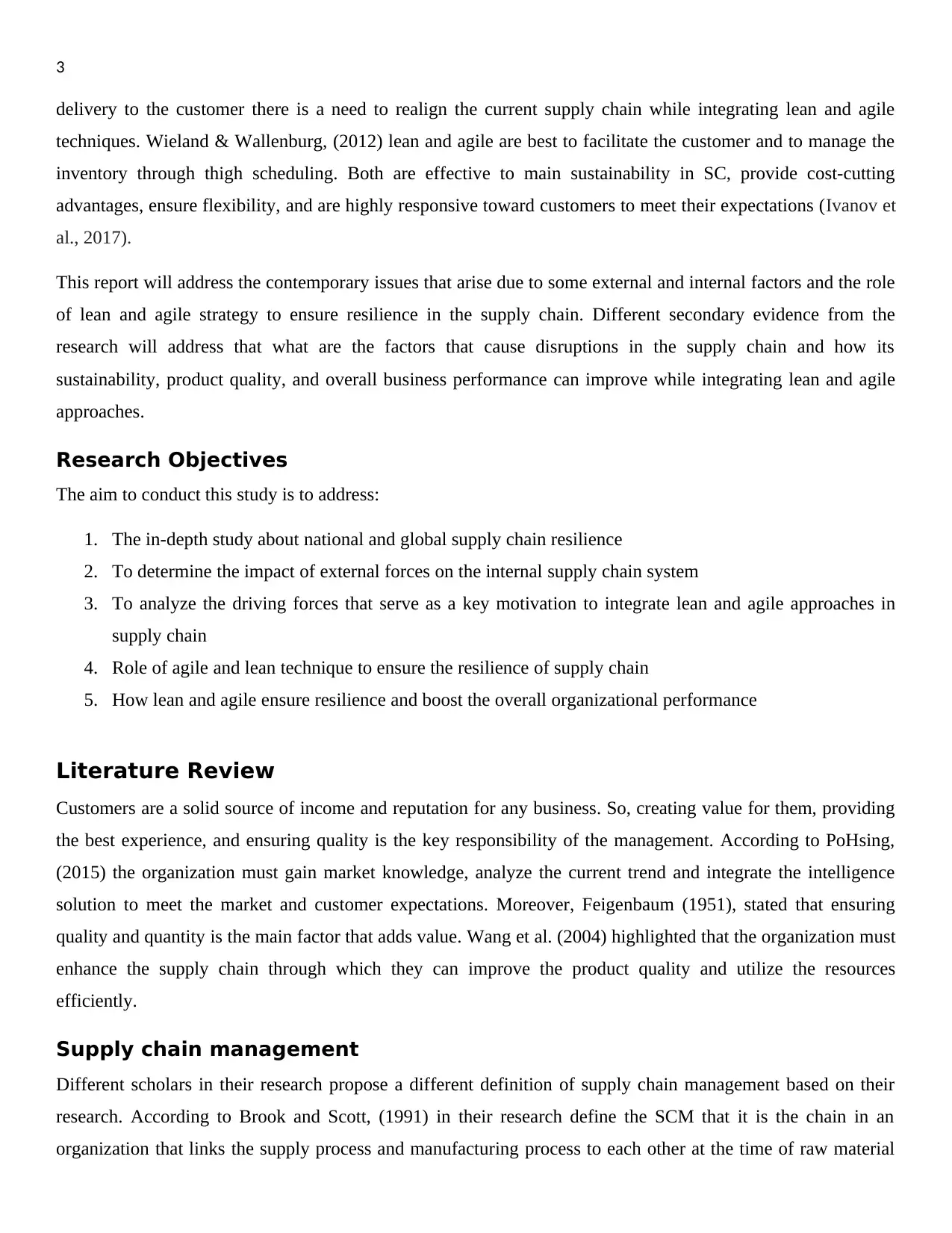
3
delivery to the customer there is a need to realign the current supply chain while integrating lean and agile
techniques. Wieland & Wallenburg, (2012) lean and agile are best to facilitate the customer and to manage the
inventory through thigh scheduling. Both are effective to main sustainability in SC, provide cost-cutting
advantages, ensure flexibility, and are highly responsive toward customers to meet their expectations (Ivanov et
al., 2017).
This report will address the contemporary issues that arise due to some external and internal factors and the role
of lean and agile strategy to ensure resilience in the supply chain. Different secondary evidence from the
research will address that what are the factors that cause disruptions in the supply chain and how its
sustainability, product quality, and overall business performance can improve while integrating lean and agile
approaches.
Research Objectives
The aim to conduct this study is to address:
1. The in-depth study about national and global supply chain resilience
2. To determine the impact of external forces on the internal supply chain system
3. To analyze the driving forces that serve as a key motivation to integrate lean and agile approaches in
supply chain
4. Role of agile and lean technique to ensure the resilience of supply chain
5. How lean and agile ensure resilience and boost the overall organizational performance
Literature Review
Customers are a solid source of income and reputation for any business. So, creating value for them, providing
the best experience, and ensuring quality is the key responsibility of the management. According to PoHsing,
(2015) the organization must gain market knowledge, analyze the current trend and integrate the intelligence
solution to meet the market and customer expectations. Moreover, Feigenbaum (1951), stated that ensuring
quality and quantity is the main factor that adds value. Wang et al. (2004) highlighted that the organization must
enhance the supply chain through which they can improve the product quality and utilize the resources
efficiently.
Supply chain management
Different scholars in their research propose a different definition of supply chain management based on their
research. According to Brook and Scott, (1991) in their research define the SCM that it is the chain in an
organization that links the supply process and manufacturing process to each other at the time of raw material
delivery to the customer there is a need to realign the current supply chain while integrating lean and agile
techniques. Wieland & Wallenburg, (2012) lean and agile are best to facilitate the customer and to manage the
inventory through thigh scheduling. Both are effective to main sustainability in SC, provide cost-cutting
advantages, ensure flexibility, and are highly responsive toward customers to meet their expectations (Ivanov et
al., 2017).
This report will address the contemporary issues that arise due to some external and internal factors and the role
of lean and agile strategy to ensure resilience in the supply chain. Different secondary evidence from the
research will address that what are the factors that cause disruptions in the supply chain and how its
sustainability, product quality, and overall business performance can improve while integrating lean and agile
approaches.
Research Objectives
The aim to conduct this study is to address:
1. The in-depth study about national and global supply chain resilience
2. To determine the impact of external forces on the internal supply chain system
3. To analyze the driving forces that serve as a key motivation to integrate lean and agile approaches in
supply chain
4. Role of agile and lean technique to ensure the resilience of supply chain
5. How lean and agile ensure resilience and boost the overall organizational performance
Literature Review
Customers are a solid source of income and reputation for any business. So, creating value for them, providing
the best experience, and ensuring quality is the key responsibility of the management. According to PoHsing,
(2015) the organization must gain market knowledge, analyze the current trend and integrate the intelligence
solution to meet the market and customer expectations. Moreover, Feigenbaum (1951), stated that ensuring
quality and quantity is the main factor that adds value. Wang et al. (2004) highlighted that the organization must
enhance the supply chain through which they can improve the product quality and utilize the resources
efficiently.
Supply chain management
Different scholars in their research propose a different definition of supply chain management based on their
research. According to Brook and Scott, (1991) in their research define the SCM that it is the chain in an
organization that links the supply process and manufacturing process to each other at the time of raw material
⊘ This is a preview!⊘
Do you want full access?
Subscribe today to unlock all pages.

Trusted by 1+ million students worldwide
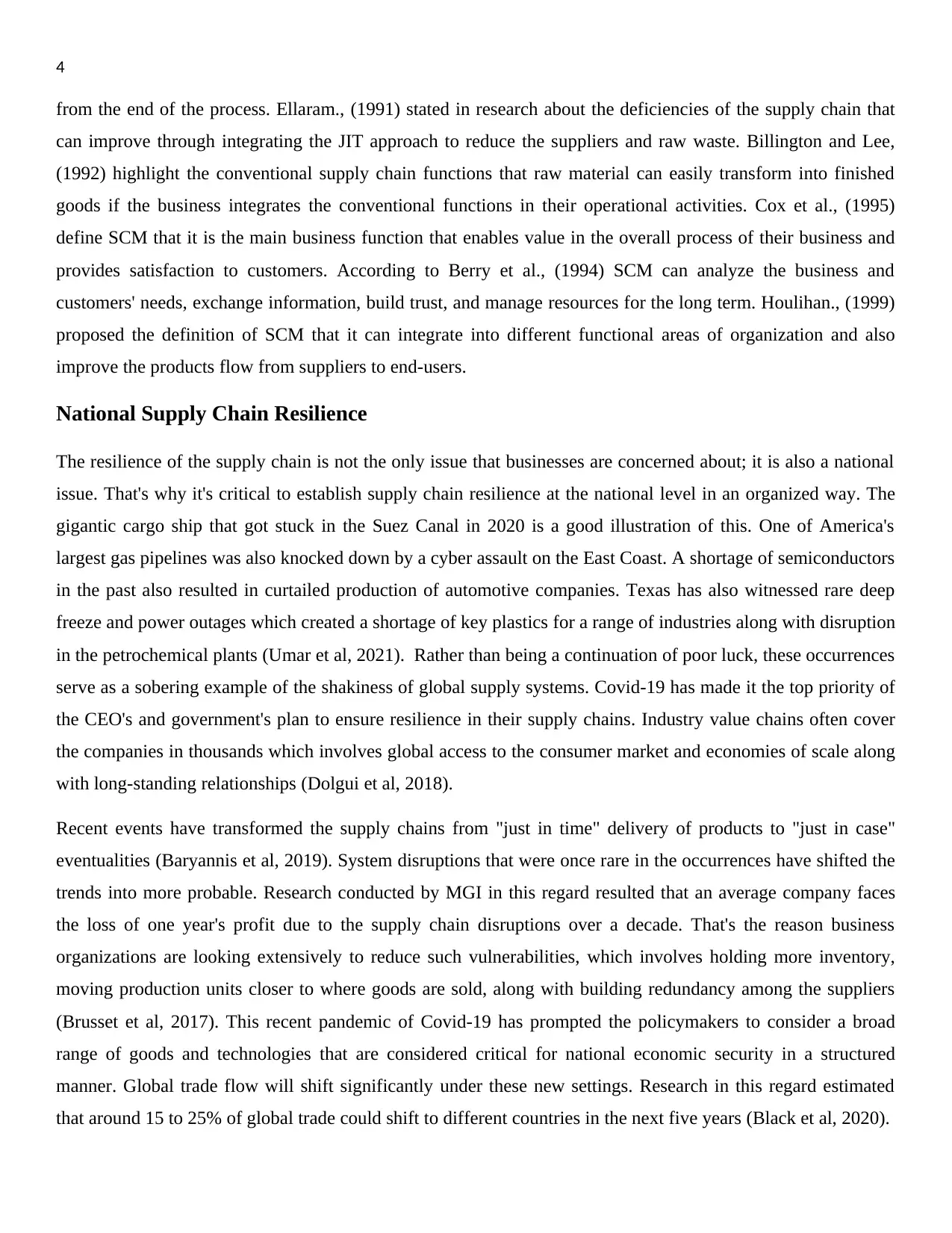
4
from the end of the process. Ellaram., (1991) stated in research about the deficiencies of the supply chain that
can improve through integrating the JIT approach to reduce the suppliers and raw waste. Billington and Lee,
(1992) highlight the conventional supply chain functions that raw material can easily transform into finished
goods if the business integrates the conventional functions in their operational activities. Cox et al., (1995)
define SCM that it is the main business function that enables value in the overall process of their business and
provides satisfaction to customers. According to Berry et al., (1994) SCM can analyze the business and
customers' needs, exchange information, build trust, and manage resources for the long term. Houlihan., (1999)
proposed the definition of SCM that it can integrate into different functional areas of organization and also
improve the products flow from suppliers to end-users.
National Supply Chain Resilience
The resilience of the supply chain is not the only issue that businesses are concerned about; it is also a national
issue. That's why it's critical to establish supply chain resilience at the national level in an organized way. The
gigantic cargo ship that got stuck in the Suez Canal in 2020 is a good illustration of this. One of America's
largest gas pipelines was also knocked down by a cyber assault on the East Coast. A shortage of semiconductors
in the past also resulted in curtailed production of automotive companies. Texas has also witnessed rare deep
freeze and power outages which created a shortage of key plastics for a range of industries along with disruption
in the petrochemical plants (Umar et al, 2021). Rather than being a continuation of poor luck, these occurrences
serve as a sobering example of the shakiness of global supply systems. Covid-19 has made it the top priority of
the CEO's and government's plan to ensure resilience in their supply chains. Industry value chains often cover
the companies in thousands which involves global access to the consumer market and economies of scale along
with long-standing relationships (Dolgui et al, 2018).
Recent events have transformed the supply chains from "just in time" delivery of products to "just in case"
eventualities (Baryannis et al, 2019). System disruptions that were once rare in the occurrences have shifted the
trends into more probable. Research conducted by MGI in this regard resulted that an average company faces
the loss of one year's profit due to the supply chain disruptions over a decade. That's the reason business
organizations are looking extensively to reduce such vulnerabilities, which involves holding more inventory,
moving production units closer to where goods are sold, along with building redundancy among the suppliers
(Brusset et al, 2017). This recent pandemic of Covid-19 has prompted the policymakers to consider a broad
range of goods and technologies that are considered critical for national economic security in a structured
manner. Global trade flow will shift significantly under these new settings. Research in this regard estimated
that around 15 to 25% of global trade could shift to different countries in the next five years (Black et al, 2020).
from the end of the process. Ellaram., (1991) stated in research about the deficiencies of the supply chain that
can improve through integrating the JIT approach to reduce the suppliers and raw waste. Billington and Lee,
(1992) highlight the conventional supply chain functions that raw material can easily transform into finished
goods if the business integrates the conventional functions in their operational activities. Cox et al., (1995)
define SCM that it is the main business function that enables value in the overall process of their business and
provides satisfaction to customers. According to Berry et al., (1994) SCM can analyze the business and
customers' needs, exchange information, build trust, and manage resources for the long term. Houlihan., (1999)
proposed the definition of SCM that it can integrate into different functional areas of organization and also
improve the products flow from suppliers to end-users.
National Supply Chain Resilience
The resilience of the supply chain is not the only issue that businesses are concerned about; it is also a national
issue. That's why it's critical to establish supply chain resilience at the national level in an organized way. The
gigantic cargo ship that got stuck in the Suez Canal in 2020 is a good illustration of this. One of America's
largest gas pipelines was also knocked down by a cyber assault on the East Coast. A shortage of semiconductors
in the past also resulted in curtailed production of automotive companies. Texas has also witnessed rare deep
freeze and power outages which created a shortage of key plastics for a range of industries along with disruption
in the petrochemical plants (Umar et al, 2021). Rather than being a continuation of poor luck, these occurrences
serve as a sobering example of the shakiness of global supply systems. Covid-19 has made it the top priority of
the CEO's and government's plan to ensure resilience in their supply chains. Industry value chains often cover
the companies in thousands which involves global access to the consumer market and economies of scale along
with long-standing relationships (Dolgui et al, 2018).
Recent events have transformed the supply chains from "just in time" delivery of products to "just in case"
eventualities (Baryannis et al, 2019). System disruptions that were once rare in the occurrences have shifted the
trends into more probable. Research conducted by MGI in this regard resulted that an average company faces
the loss of one year's profit due to the supply chain disruptions over a decade. That's the reason business
organizations are looking extensively to reduce such vulnerabilities, which involves holding more inventory,
moving production units closer to where goods are sold, along with building redundancy among the suppliers
(Brusset et al, 2017). This recent pandemic of Covid-19 has prompted the policymakers to consider a broad
range of goods and technologies that are considered critical for national economic security in a structured
manner. Global trade flow will shift significantly under these new settings. Research in this regard estimated
that around 15 to 25% of global trade could shift to different countries in the next five years (Black et al, 2020).
Paraphrase This Document
Need a fresh take? Get an instant paraphrase of this document with our AI Paraphraser
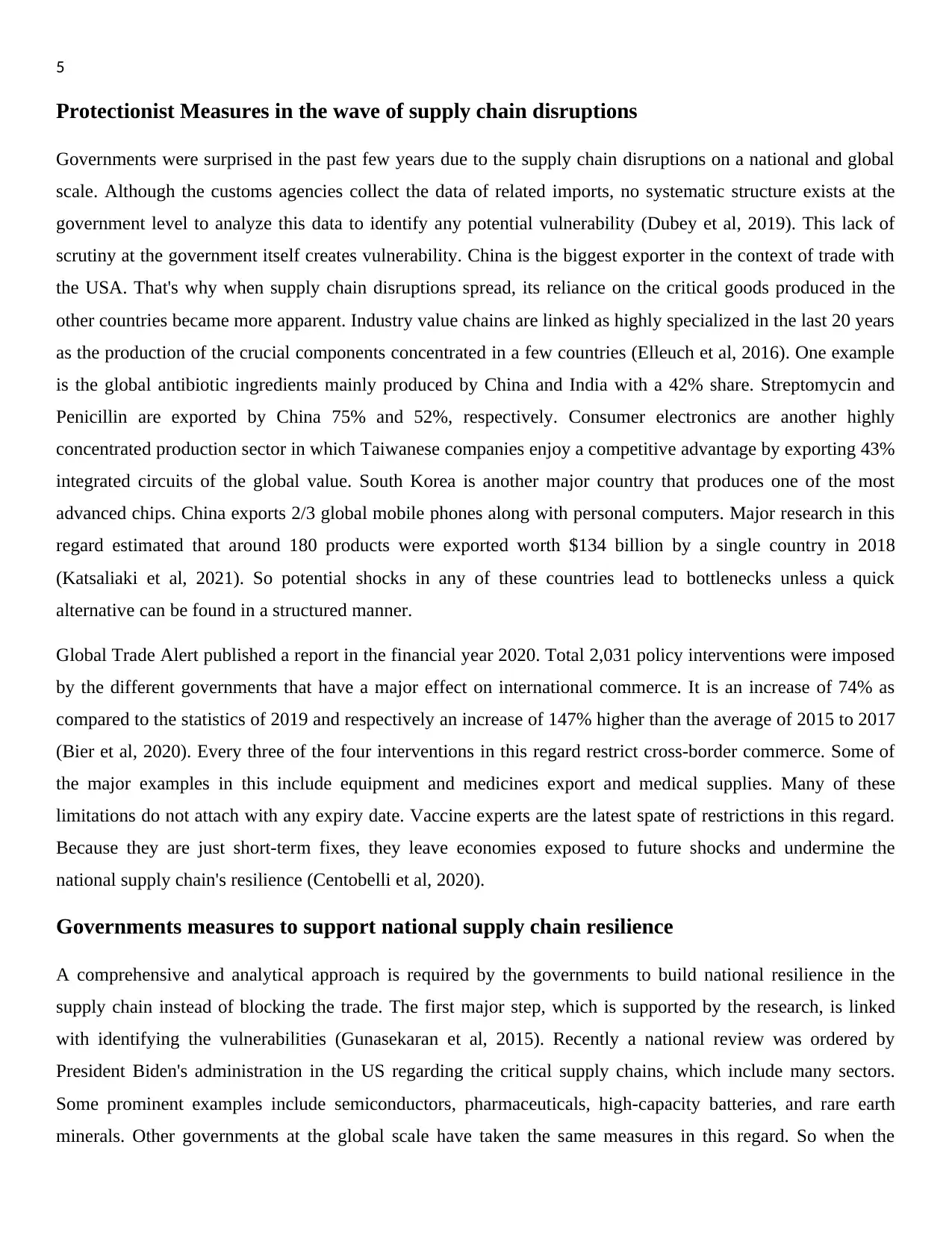
5
Protectionist Measures in the wave of supply chain disruptions
Governments were surprised in the past few years due to the supply chain disruptions on a national and global
scale. Although the customs agencies collect the data of related imports, no systematic structure exists at the
government level to analyze this data to identify any potential vulnerability (Dubey et al, 2019). This lack of
scrutiny at the government itself creates vulnerability. China is the biggest exporter in the context of trade with
the USA. That's why when supply chain disruptions spread, its reliance on the critical goods produced in the
other countries became more apparent. Industry value chains are linked as highly specialized in the last 20 years
as the production of the crucial components concentrated in a few countries (Elleuch et al, 2016). One example
is the global antibiotic ingredients mainly produced by China and India with a 42% share. Streptomycin and
Penicillin are exported by China 75% and 52%, respectively. Consumer electronics are another highly
concentrated production sector in which Taiwanese companies enjoy a competitive advantage by exporting 43%
integrated circuits of the global value. South Korea is another major country that produces one of the most
advanced chips. China exports 2/3 global mobile phones along with personal computers. Major research in this
regard estimated that around 180 products were exported worth $134 billion by a single country in 2018
(Katsaliaki et al, 2021). So potential shocks in any of these countries lead to bottlenecks unless a quick
alternative can be found in a structured manner.
Global Trade Alert published a report in the financial year 2020. Total 2,031 policy interventions were imposed
by the different governments that have a major effect on international commerce. It is an increase of 74% as
compared to the statistics of 2019 and respectively an increase of 147% higher than the average of 2015 to 2017
(Bier et al, 2020). Every three of the four interventions in this regard restrict cross-border commerce. Some of
the major examples in this include equipment and medicines export and medical supplies. Many of these
limitations do not attach with any expiry date. Vaccine experts are the latest spate of restrictions in this regard.
Because they are just short-term fixes, they leave economies exposed to future shocks and undermine the
national supply chain's resilience (Centobelli et al, 2020).
Governments measures to support national supply chain resilience
A comprehensive and analytical approach is required by the governments to build national resilience in the
supply chain instead of blocking the trade. The first major step, which is supported by the research, is linked
with identifying the vulnerabilities (Gunasekaran et al, 2015). Recently a national review was ordered by
President Biden's administration in the US regarding the critical supply chains, which include many sectors.
Some prominent examples include semiconductors, pharmaceuticals, high-capacity batteries, and rare earth
minerals. Other governments at the global scale have taken the same measures in this regard. So when the
Protectionist Measures in the wave of supply chain disruptions
Governments were surprised in the past few years due to the supply chain disruptions on a national and global
scale. Although the customs agencies collect the data of related imports, no systematic structure exists at the
government level to analyze this data to identify any potential vulnerability (Dubey et al, 2019). This lack of
scrutiny at the government itself creates vulnerability. China is the biggest exporter in the context of trade with
the USA. That's why when supply chain disruptions spread, its reliance on the critical goods produced in the
other countries became more apparent. Industry value chains are linked as highly specialized in the last 20 years
as the production of the crucial components concentrated in a few countries (Elleuch et al, 2016). One example
is the global antibiotic ingredients mainly produced by China and India with a 42% share. Streptomycin and
Penicillin are exported by China 75% and 52%, respectively. Consumer electronics are another highly
concentrated production sector in which Taiwanese companies enjoy a competitive advantage by exporting 43%
integrated circuits of the global value. South Korea is another major country that produces one of the most
advanced chips. China exports 2/3 global mobile phones along with personal computers. Major research in this
regard estimated that around 180 products were exported worth $134 billion by a single country in 2018
(Katsaliaki et al, 2021). So potential shocks in any of these countries lead to bottlenecks unless a quick
alternative can be found in a structured manner.
Global Trade Alert published a report in the financial year 2020. Total 2,031 policy interventions were imposed
by the different governments that have a major effect on international commerce. It is an increase of 74% as
compared to the statistics of 2019 and respectively an increase of 147% higher than the average of 2015 to 2017
(Bier et al, 2020). Every three of the four interventions in this regard restrict cross-border commerce. Some of
the major examples in this include equipment and medicines export and medical supplies. Many of these
limitations do not attach with any expiry date. Vaccine experts are the latest spate of restrictions in this regard.
Because they are just short-term fixes, they leave economies exposed to future shocks and undermine the
national supply chain's resilience (Centobelli et al, 2020).
Governments measures to support national supply chain resilience
A comprehensive and analytical approach is required by the governments to build national resilience in the
supply chain instead of blocking the trade. The first major step, which is supported by the research, is linked
with identifying the vulnerabilities (Gunasekaran et al, 2015). Recently a national review was ordered by
President Biden's administration in the US regarding the critical supply chains, which include many sectors.
Some prominent examples include semiconductors, pharmaceuticals, high-capacity batteries, and rare earth
minerals. Other governments at the global scale have taken the same measures in this regard. So when the
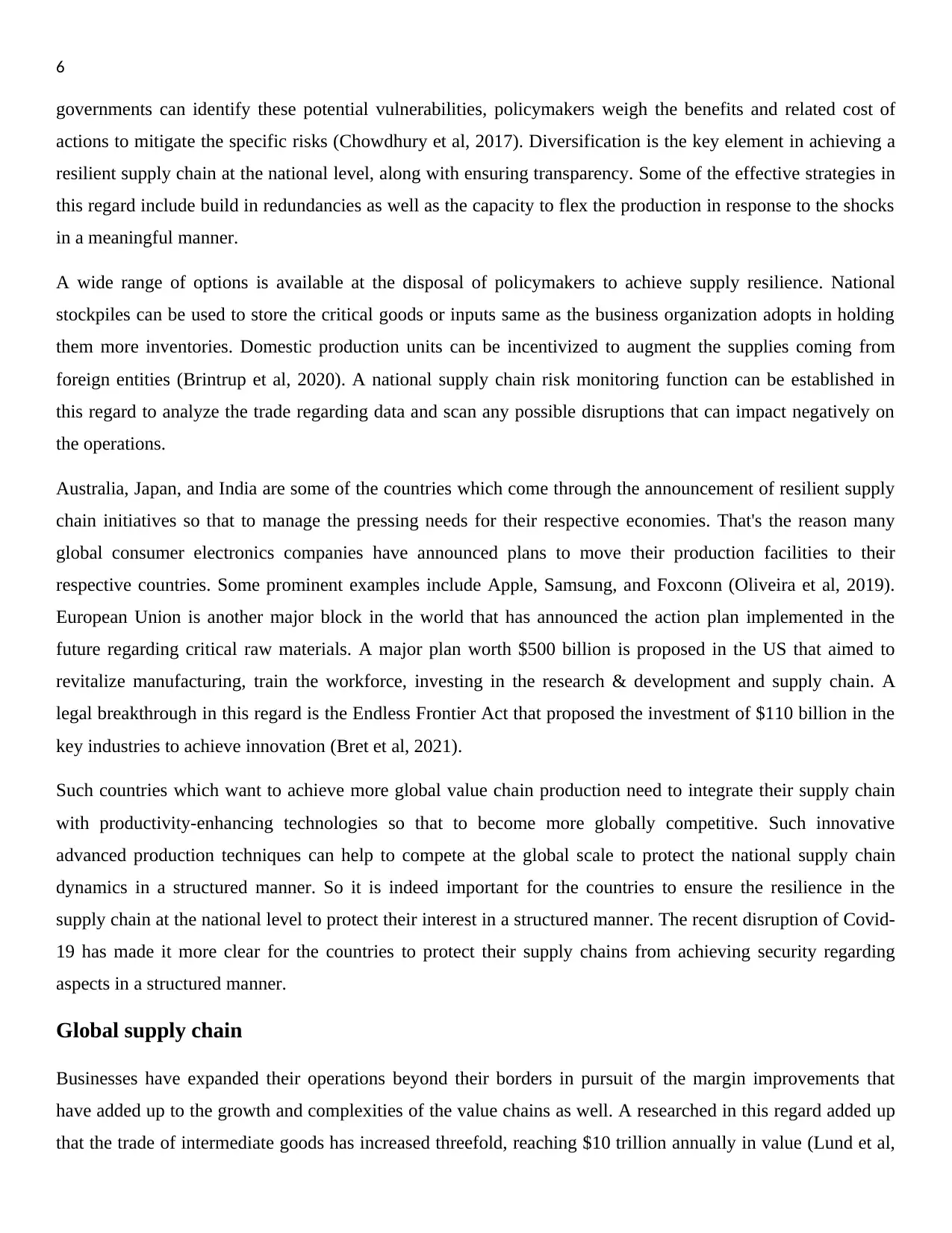
6
governments can identify these potential vulnerabilities, policymakers weigh the benefits and related cost of
actions to mitigate the specific risks (Chowdhury et al, 2017). Diversification is the key element in achieving a
resilient supply chain at the national level, along with ensuring transparency. Some of the effective strategies in
this regard include build in redundancies as well as the capacity to flex the production in response to the shocks
in a meaningful manner.
A wide range of options is available at the disposal of policymakers to achieve supply resilience. National
stockpiles can be used to store the critical goods or inputs same as the business organization adopts in holding
them more inventories. Domestic production units can be incentivized to augment the supplies coming from
foreign entities (Brintrup et al, 2020). A national supply chain risk monitoring function can be established in
this regard to analyze the trade regarding data and scan any possible disruptions that can impact negatively on
the operations.
Australia, Japan, and India are some of the countries which come through the announcement of resilient supply
chain initiatives so that to manage the pressing needs for their respective economies. That's the reason many
global consumer electronics companies have announced plans to move their production facilities to their
respective countries. Some prominent examples include Apple, Samsung, and Foxconn (Oliveira et al, 2019).
European Union is another major block in the world that has announced the action plan implemented in the
future regarding critical raw materials. A major plan worth $500 billion is proposed in the US that aimed to
revitalize manufacturing, train the workforce, investing in the research & development and supply chain. A
legal breakthrough in this regard is the Endless Frontier Act that proposed the investment of $110 billion in the
key industries to achieve innovation (Bret et al, 2021).
Such countries which want to achieve more global value chain production need to integrate their supply chain
with productivity-enhancing technologies so that to become more globally competitive. Such innovative
advanced production techniques can help to compete at the global scale to protect the national supply chain
dynamics in a structured manner. So it is indeed important for the countries to ensure the resilience in the
supply chain at the national level to protect their interest in a structured manner. The recent disruption of Covid-
19 has made it more clear for the countries to protect their supply chains from achieving security regarding
aspects in a structured manner.
Global supply chain
Businesses have expanded their operations beyond their borders in pursuit of the margin improvements that
have added up to the growth and complexities of the value chains as well. A researched in this regard added up
that the trade of intermediate goods has increased threefold, reaching $10 trillion annually in value (Lund et al,
governments can identify these potential vulnerabilities, policymakers weigh the benefits and related cost of
actions to mitigate the specific risks (Chowdhury et al, 2017). Diversification is the key element in achieving a
resilient supply chain at the national level, along with ensuring transparency. Some of the effective strategies in
this regard include build in redundancies as well as the capacity to flex the production in response to the shocks
in a meaningful manner.
A wide range of options is available at the disposal of policymakers to achieve supply resilience. National
stockpiles can be used to store the critical goods or inputs same as the business organization adopts in holding
them more inventories. Domestic production units can be incentivized to augment the supplies coming from
foreign entities (Brintrup et al, 2020). A national supply chain risk monitoring function can be established in
this regard to analyze the trade regarding data and scan any possible disruptions that can impact negatively on
the operations.
Australia, Japan, and India are some of the countries which come through the announcement of resilient supply
chain initiatives so that to manage the pressing needs for their respective economies. That's the reason many
global consumer electronics companies have announced plans to move their production facilities to their
respective countries. Some prominent examples include Apple, Samsung, and Foxconn (Oliveira et al, 2019).
European Union is another major block in the world that has announced the action plan implemented in the
future regarding critical raw materials. A major plan worth $500 billion is proposed in the US that aimed to
revitalize manufacturing, train the workforce, investing in the research & development and supply chain. A
legal breakthrough in this regard is the Endless Frontier Act that proposed the investment of $110 billion in the
key industries to achieve innovation (Bret et al, 2021).
Such countries which want to achieve more global value chain production need to integrate their supply chain
with productivity-enhancing technologies so that to become more globally competitive. Such innovative
advanced production techniques can help to compete at the global scale to protect the national supply chain
dynamics in a structured manner. So it is indeed important for the countries to ensure the resilience in the
supply chain at the national level to protect their interest in a structured manner. The recent disruption of Covid-
19 has made it more clear for the countries to protect their supply chains from achieving security regarding
aspects in a structured manner.
Global supply chain
Businesses have expanded their operations beyond their borders in pursuit of the margin improvements that
have added up to the growth and complexities of the value chains as well. A researched in this regard added up
that the trade of intermediate goods has increased threefold, reaching $10 trillion annually in value (Lund et al,
⊘ This is a preview!⊘
Do you want full access?
Subscribe today to unlock all pages.

Trusted by 1+ million students worldwide
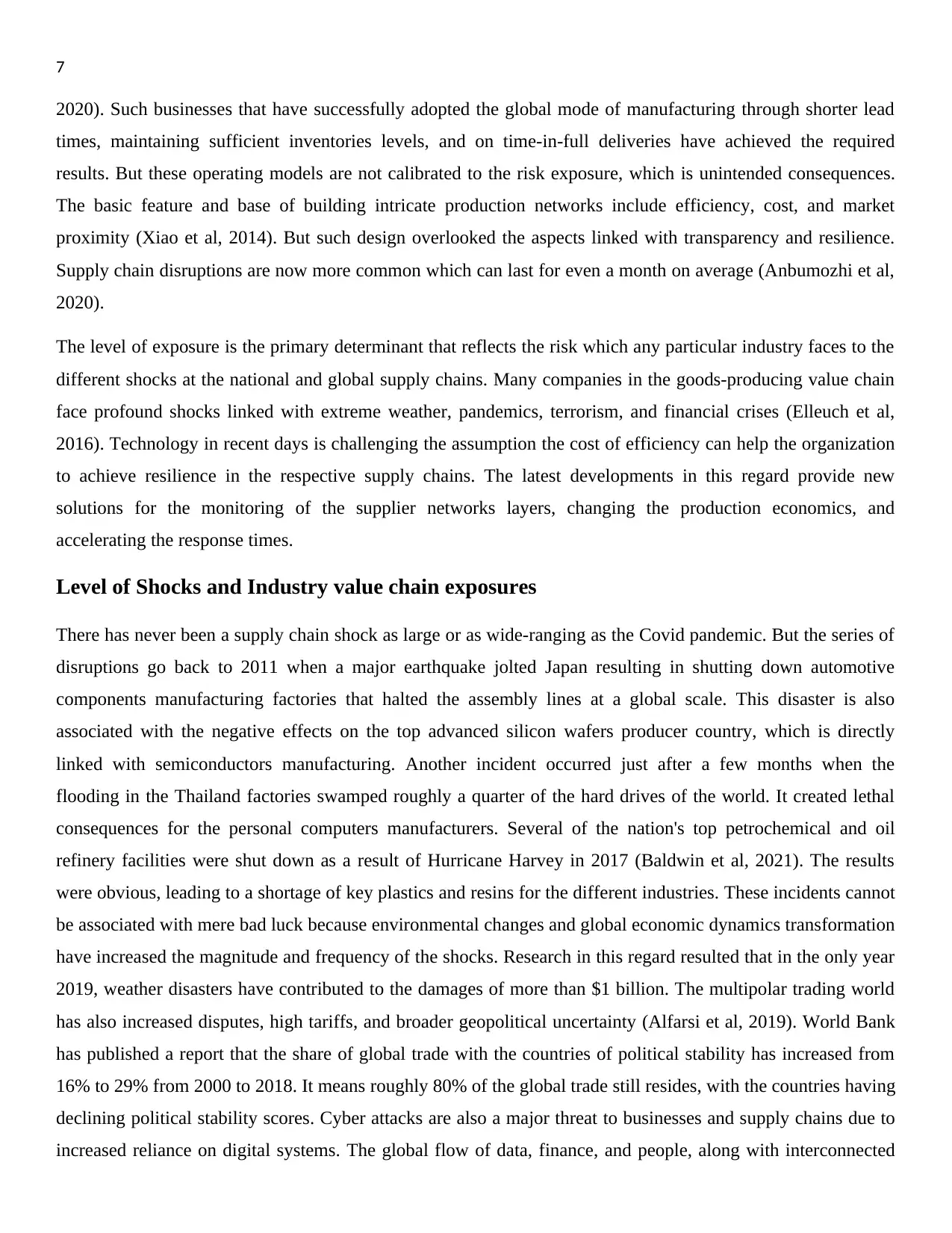
7
2020). Such businesses that have successfully adopted the global mode of manufacturing through shorter lead
times, maintaining sufficient inventories levels, and on time-in-full deliveries have achieved the required
results. But these operating models are not calibrated to the risk exposure, which is unintended consequences.
The basic feature and base of building intricate production networks include efficiency, cost, and market
proximity (Xiao et al, 2014). But such design overlooked the aspects linked with transparency and resilience.
Supply chain disruptions are now more common which can last for even a month on average (Anbumozhi et al,
2020).
The level of exposure is the primary determinant that reflects the risk which any particular industry faces to the
different shocks at the national and global supply chains. Many companies in the goods-producing value chain
face profound shocks linked with extreme weather, pandemics, terrorism, and financial crises (Elleuch et al,
2016). Technology in recent days is challenging the assumption the cost of efficiency can help the organization
to achieve resilience in the respective supply chains. The latest developments in this regard provide new
solutions for the monitoring of the supplier networks layers, changing the production economics, and
accelerating the response times.
Level of Shocks and Industry value chain exposures
There has never been a supply chain shock as large or as wide-ranging as the Covid pandemic. But the series of
disruptions go back to 2011 when a major earthquake jolted Japan resulting in shutting down automotive
components manufacturing factories that halted the assembly lines at a global scale. This disaster is also
associated with the negative effects on the top advanced silicon wafers producer country, which is directly
linked with semiconductors manufacturing. Another incident occurred just after a few months when the
flooding in the Thailand factories swamped roughly a quarter of the hard drives of the world. It created lethal
consequences for the personal computers manufacturers. Several of the nation's top petrochemical and oil
refinery facilities were shut down as a result of Hurricane Harvey in 2017 (Baldwin et al, 2021). The results
were obvious, leading to a shortage of key plastics and resins for the different industries. These incidents cannot
be associated with mere bad luck because environmental changes and global economic dynamics transformation
have increased the magnitude and frequency of the shocks. Research in this regard resulted that in the only year
2019, weather disasters have contributed to the damages of more than $1 billion. The multipolar trading world
has also increased disputes, high tariffs, and broader geopolitical uncertainty (Alfarsi et al, 2019). World Bank
has published a report that the share of global trade with the countries of political stability has increased from
16% to 29% from 2000 to 2018. It means roughly 80% of the global trade still resides, with the countries having
declining political stability scores. Cyber attacks are also a major threat to businesses and supply chains due to
increased reliance on digital systems. The global flow of data, finance, and people, along with interconnected
2020). Such businesses that have successfully adopted the global mode of manufacturing through shorter lead
times, maintaining sufficient inventories levels, and on time-in-full deliveries have achieved the required
results. But these operating models are not calibrated to the risk exposure, which is unintended consequences.
The basic feature and base of building intricate production networks include efficiency, cost, and market
proximity (Xiao et al, 2014). But such design overlooked the aspects linked with transparency and resilience.
Supply chain disruptions are now more common which can last for even a month on average (Anbumozhi et al,
2020).
The level of exposure is the primary determinant that reflects the risk which any particular industry faces to the
different shocks at the national and global supply chains. Many companies in the goods-producing value chain
face profound shocks linked with extreme weather, pandemics, terrorism, and financial crises (Elleuch et al,
2016). Technology in recent days is challenging the assumption the cost of efficiency can help the organization
to achieve resilience in the respective supply chains. The latest developments in this regard provide new
solutions for the monitoring of the supplier networks layers, changing the production economics, and
accelerating the response times.
Level of Shocks and Industry value chain exposures
There has never been a supply chain shock as large or as wide-ranging as the Covid pandemic. But the series of
disruptions go back to 2011 when a major earthquake jolted Japan resulting in shutting down automotive
components manufacturing factories that halted the assembly lines at a global scale. This disaster is also
associated with the negative effects on the top advanced silicon wafers producer country, which is directly
linked with semiconductors manufacturing. Another incident occurred just after a few months when the
flooding in the Thailand factories swamped roughly a quarter of the hard drives of the world. It created lethal
consequences for the personal computers manufacturers. Several of the nation's top petrochemical and oil
refinery facilities were shut down as a result of Hurricane Harvey in 2017 (Baldwin et al, 2021). The results
were obvious, leading to a shortage of key plastics and resins for the different industries. These incidents cannot
be associated with mere bad luck because environmental changes and global economic dynamics transformation
have increased the magnitude and frequency of the shocks. Research in this regard resulted that in the only year
2019, weather disasters have contributed to the damages of more than $1 billion. The multipolar trading world
has also increased disputes, high tariffs, and broader geopolitical uncertainty (Alfarsi et al, 2019). World Bank
has published a report that the share of global trade with the countries of political stability has increased from
16% to 29% from 2000 to 2018. It means roughly 80% of the global trade still resides, with the countries having
declining political stability scores. Cyber attacks are also a major threat to businesses and supply chains due to
increased reliance on digital systems. The global flow of data, finance, and people, along with interconnected
Paraphrase This Document
Need a fresh take? Get an instant paraphrase of this document with our AI Paraphraser
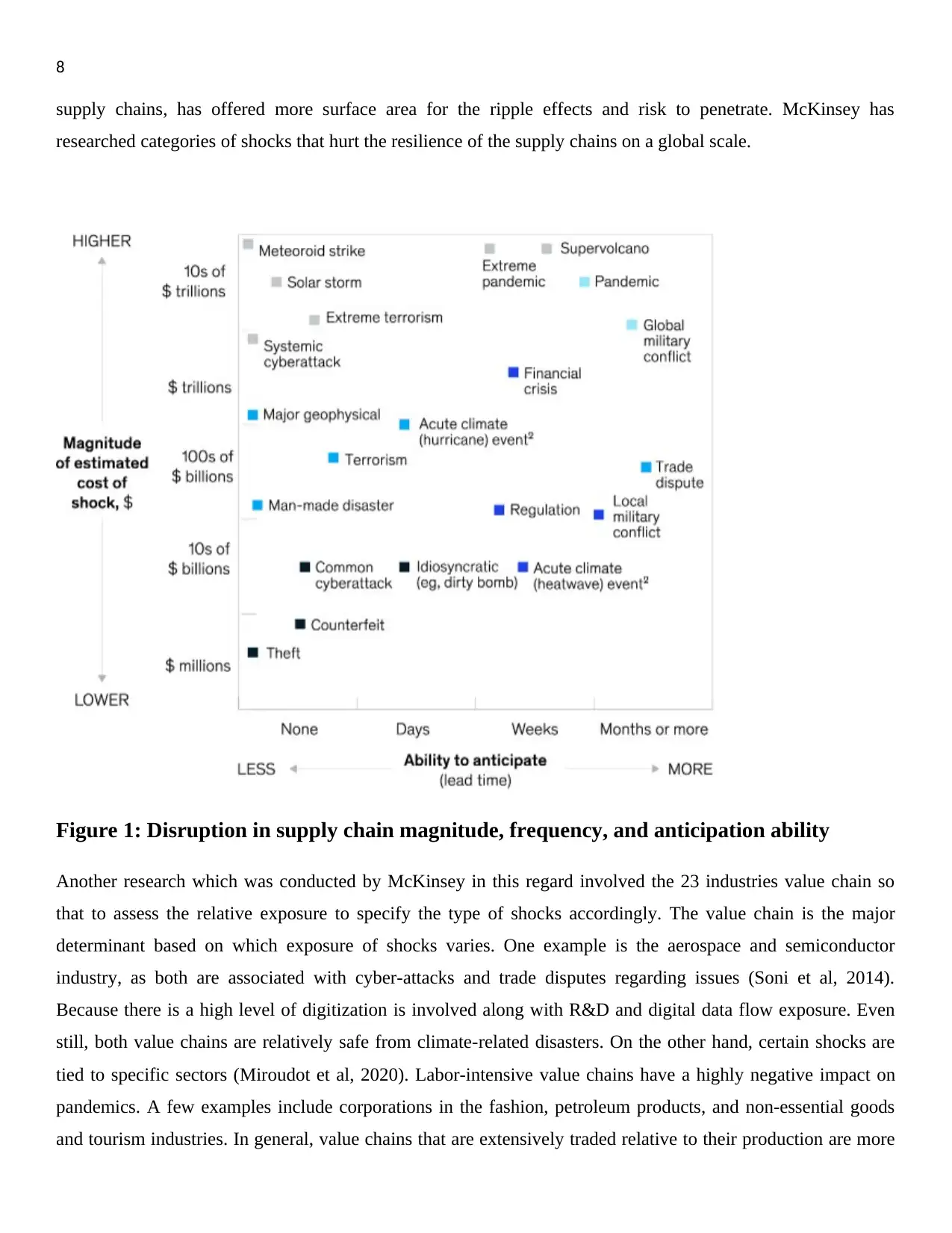
8
supply chains, has offered more surface area for the ripple effects and risk to penetrate. McKinsey has
researched categories of shocks that hurt the resilience of the supply chains on a global scale.
Figure 1: Disruption in supply chain magnitude, frequency, and anticipation ability
Another research which was conducted by McKinsey in this regard involved the 23 industries value chain so
that to assess the relative exposure to specify the type of shocks accordingly. The value chain is the major
determinant based on which exposure of shocks varies. One example is the aerospace and semiconductor
industry, as both are associated with cyber-attacks and trade disputes regarding issues (Soni et al, 2014).
Because there is a high level of digitization is involved along with R&D and digital data flow exposure. Even
still, both value chains are relatively safe from climate-related disasters. On the other hand, certain shocks are
tied to specific sectors (Miroudot et al, 2020). Labor-intensive value chains have a highly negative impact on
pandemics. A few examples include corporations in the fashion, petroleum products, and non-essential goods
and tourism industries. In general, value chains that are extensively traded relative to their production are more
supply chains, has offered more surface area for the ripple effects and risk to penetrate. McKinsey has
researched categories of shocks that hurt the resilience of the supply chains on a global scale.
Figure 1: Disruption in supply chain magnitude, frequency, and anticipation ability
Another research which was conducted by McKinsey in this regard involved the 23 industries value chain so
that to assess the relative exposure to specify the type of shocks accordingly. The value chain is the major
determinant based on which exposure of shocks varies. One example is the aerospace and semiconductor
industry, as both are associated with cyber-attacks and trade disputes regarding issues (Soni et al, 2014).
Because there is a high level of digitization is involved along with R&D and digital data flow exposure. Even
still, both value chains are relatively safe from climate-related disasters. On the other hand, certain shocks are
tied to specific sectors (Miroudot et al, 2020). Labor-intensive value chains have a highly negative impact on
pandemics. A few examples include corporations in the fashion, petroleum products, and non-essential goods
and tourism industries. In general, value chains that are extensively traded relative to their production are more
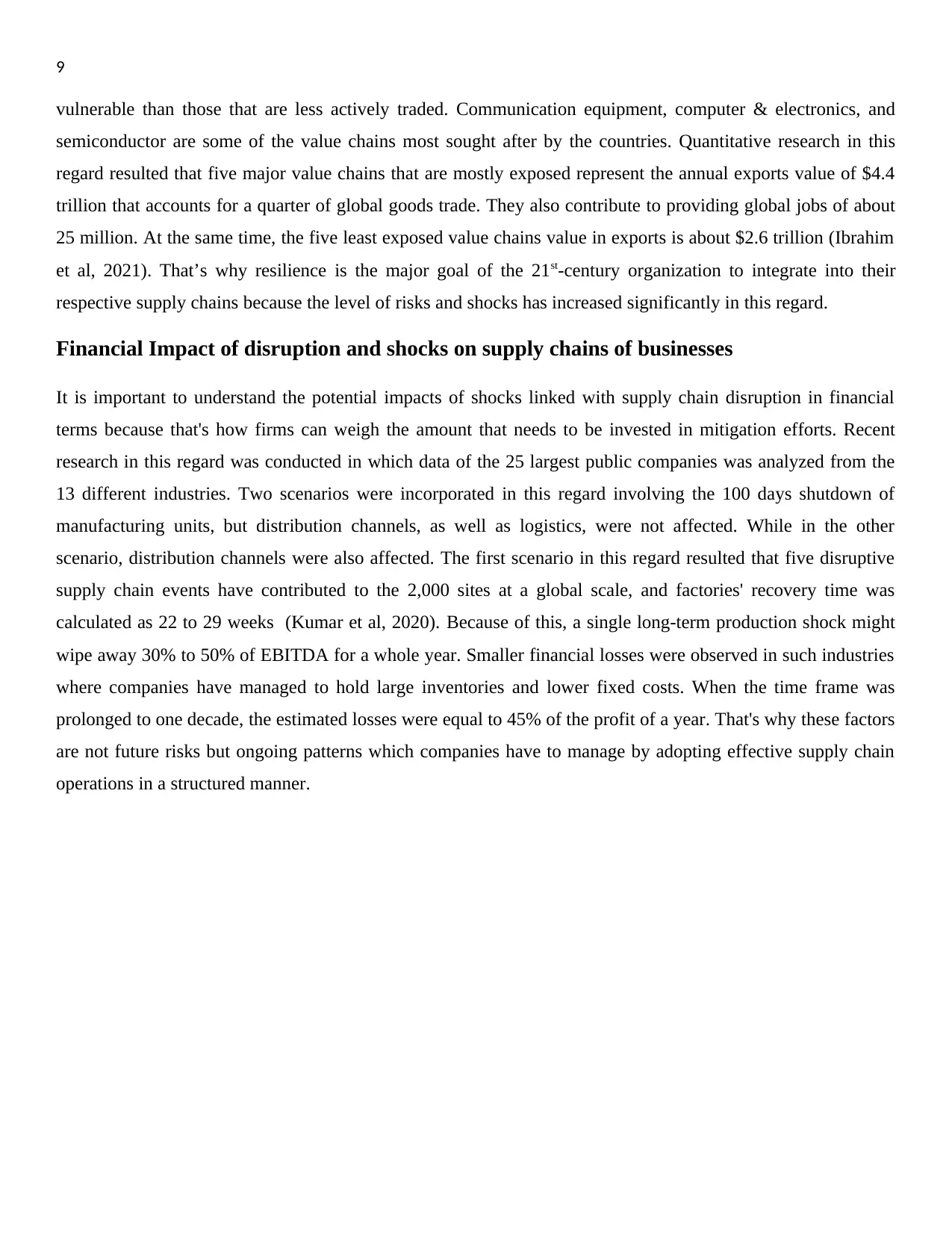
9
vulnerable than those that are less actively traded. Communication equipment, computer & electronics, and
semiconductor are some of the value chains most sought after by the countries. Quantitative research in this
regard resulted that five major value chains that are mostly exposed represent the annual exports value of $4.4
trillion that accounts for a quarter of global goods trade. They also contribute to providing global jobs of about
25 million. At the same time, the five least exposed value chains value in exports is about $2.6 trillion (Ibrahim
et al, 2021). That’s why resilience is the major goal of the 21st-century organization to integrate into their
respective supply chains because the level of risks and shocks has increased significantly in this regard.
Financial Impact of disruption and shocks on supply chains of businesses
It is important to understand the potential impacts of shocks linked with supply chain disruption in financial
terms because that's how firms can weigh the amount that needs to be invested in mitigation efforts. Recent
research in this regard was conducted in which data of the 25 largest public companies was analyzed from the
13 different industries. Two scenarios were incorporated in this regard involving the 100 days shutdown of
manufacturing units, but distribution channels, as well as logistics, were not affected. While in the other
scenario, distribution channels were also affected. The first scenario in this regard resulted that five disruptive
supply chain events have contributed to the 2,000 sites at a global scale, and factories' recovery time was
calculated as 22 to 29 weeks (Kumar et al, 2020). Because of this, a single long-term production shock might
wipe away 30% to 50% of EBITDA for a whole year. Smaller financial losses were observed in such industries
where companies have managed to hold large inventories and lower fixed costs. When the time frame was
prolonged to one decade, the estimated losses were equal to 45% of the profit of a year. That's why these factors
are not future risks but ongoing patterns which companies have to manage by adopting effective supply chain
operations in a structured manner.
vulnerable than those that are less actively traded. Communication equipment, computer & electronics, and
semiconductor are some of the value chains most sought after by the countries. Quantitative research in this
regard resulted that five major value chains that are mostly exposed represent the annual exports value of $4.4
trillion that accounts for a quarter of global goods trade. They also contribute to providing global jobs of about
25 million. At the same time, the five least exposed value chains value in exports is about $2.6 trillion (Ibrahim
et al, 2021). That’s why resilience is the major goal of the 21st-century organization to integrate into their
respective supply chains because the level of risks and shocks has increased significantly in this regard.
Financial Impact of disruption and shocks on supply chains of businesses
It is important to understand the potential impacts of shocks linked with supply chain disruption in financial
terms because that's how firms can weigh the amount that needs to be invested in mitigation efforts. Recent
research in this regard was conducted in which data of the 25 largest public companies was analyzed from the
13 different industries. Two scenarios were incorporated in this regard involving the 100 days shutdown of
manufacturing units, but distribution channels, as well as logistics, were not affected. While in the other
scenario, distribution channels were also affected. The first scenario in this regard resulted that five disruptive
supply chain events have contributed to the 2,000 sites at a global scale, and factories' recovery time was
calculated as 22 to 29 weeks (Kumar et al, 2020). Because of this, a single long-term production shock might
wipe away 30% to 50% of EBITDA for a whole year. Smaller financial losses were observed in such industries
where companies have managed to hold large inventories and lower fixed costs. When the time frame was
prolonged to one decade, the estimated losses were equal to 45% of the profit of a year. That's why these factors
are not future risks but ongoing patterns which companies have to manage by adopting effective supply chain
operations in a structured manner.
⊘ This is a preview!⊘
Do you want full access?
Subscribe today to unlock all pages.

Trusted by 1+ million students worldwide
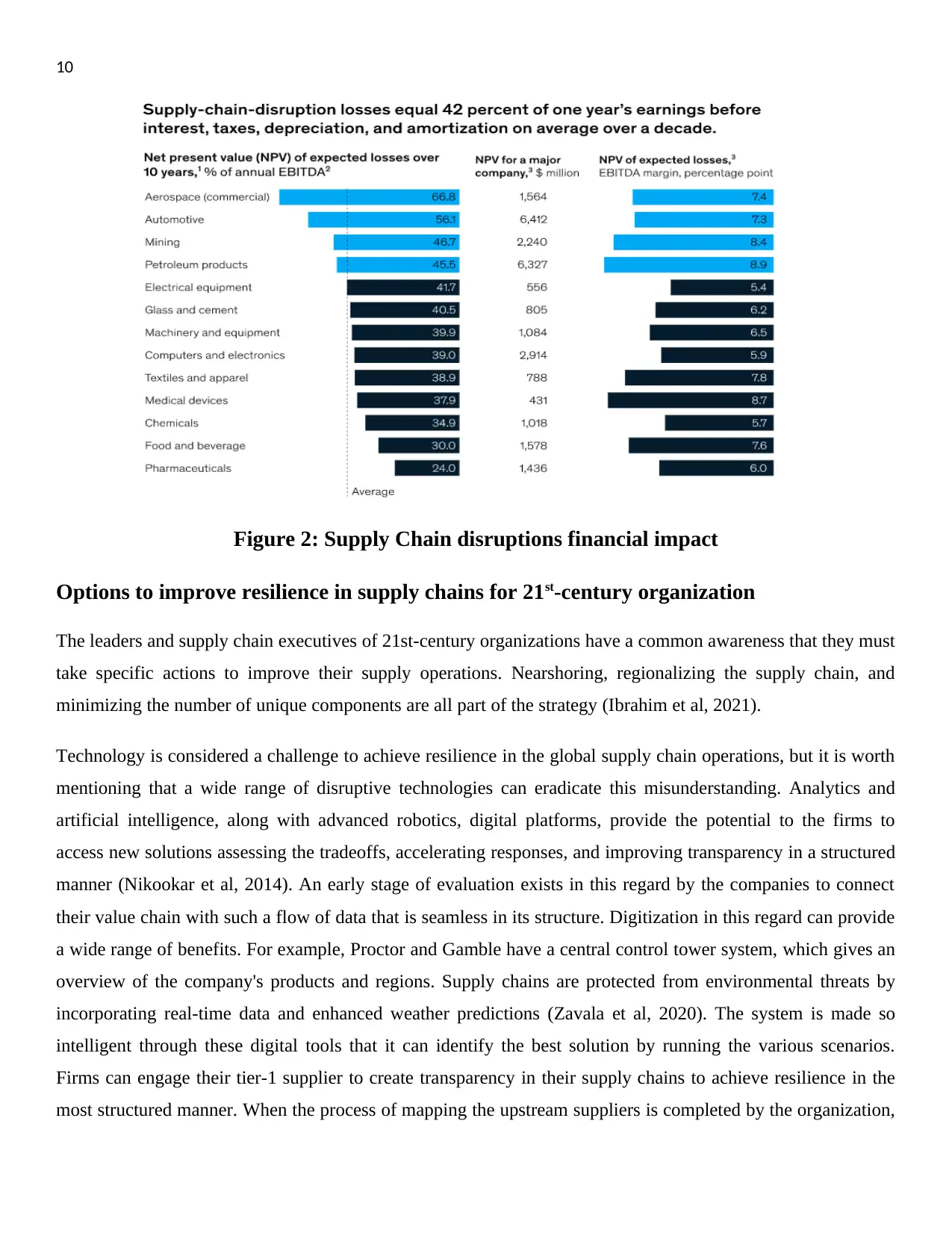
10
Figure 2: Supply Chain disruptions financial impact
Options to improve resilience in supply chains for 21st-century organization
The leaders and supply chain executives of 21st-century organizations have a common awareness that they must
take specific actions to improve their supply operations. Nearshoring, regionalizing the supply chain, and
minimizing the number of unique components are all part of the strategy (Ibrahim et al, 2021).
Technology is considered a challenge to achieve resilience in the global supply chain operations, but it is worth
mentioning that a wide range of disruptive technologies can eradicate this misunderstanding. Analytics and
artificial intelligence, along with advanced robotics, digital platforms, provide the potential to the firms to
access new solutions assessing the tradeoffs, accelerating responses, and improving transparency in a structured
manner (Nikookar et al, 2014). An early stage of evaluation exists in this regard by the companies to connect
their value chain with such a flow of data that is seamless in its structure. Digitization in this regard can provide
a wide range of benefits. For example, Proctor and Gamble have a central control tower system, which gives an
overview of the company's products and regions. Supply chains are protected from environmental threats by
incorporating real-time data and enhanced weather predictions (Zavala et al, 2020). The system is made so
intelligent through these digital tools that it can identify the best solution by running the various scenarios.
Firms can engage their tier-1 supplier to create transparency in their supply chains to achieve resilience in the
most structured manner. When the process of mapping the upstream suppliers is completed by the organization,
Figure 2: Supply Chain disruptions financial impact
Options to improve resilience in supply chains for 21st-century organization
The leaders and supply chain executives of 21st-century organizations have a common awareness that they must
take specific actions to improve their supply operations. Nearshoring, regionalizing the supply chain, and
minimizing the number of unique components are all part of the strategy (Ibrahim et al, 2021).
Technology is considered a challenge to achieve resilience in the global supply chain operations, but it is worth
mentioning that a wide range of disruptive technologies can eradicate this misunderstanding. Analytics and
artificial intelligence, along with advanced robotics, digital platforms, provide the potential to the firms to
access new solutions assessing the tradeoffs, accelerating responses, and improving transparency in a structured
manner (Nikookar et al, 2014). An early stage of evaluation exists in this regard by the companies to connect
their value chain with such a flow of data that is seamless in its structure. Digitization in this regard can provide
a wide range of benefits. For example, Proctor and Gamble have a central control tower system, which gives an
overview of the company's products and regions. Supply chains are protected from environmental threats by
incorporating real-time data and enhanced weather predictions (Zavala et al, 2020). The system is made so
intelligent through these digital tools that it can identify the best solution by running the various scenarios.
Firms can engage their tier-1 supplier to create transparency in their supply chains to achieve resilience in the
most structured manner. When the process of mapping the upstream suppliers is completed by the organization,
Paraphrase This Document
Need a fresh take? Get an instant paraphrase of this document with our AI Paraphraser
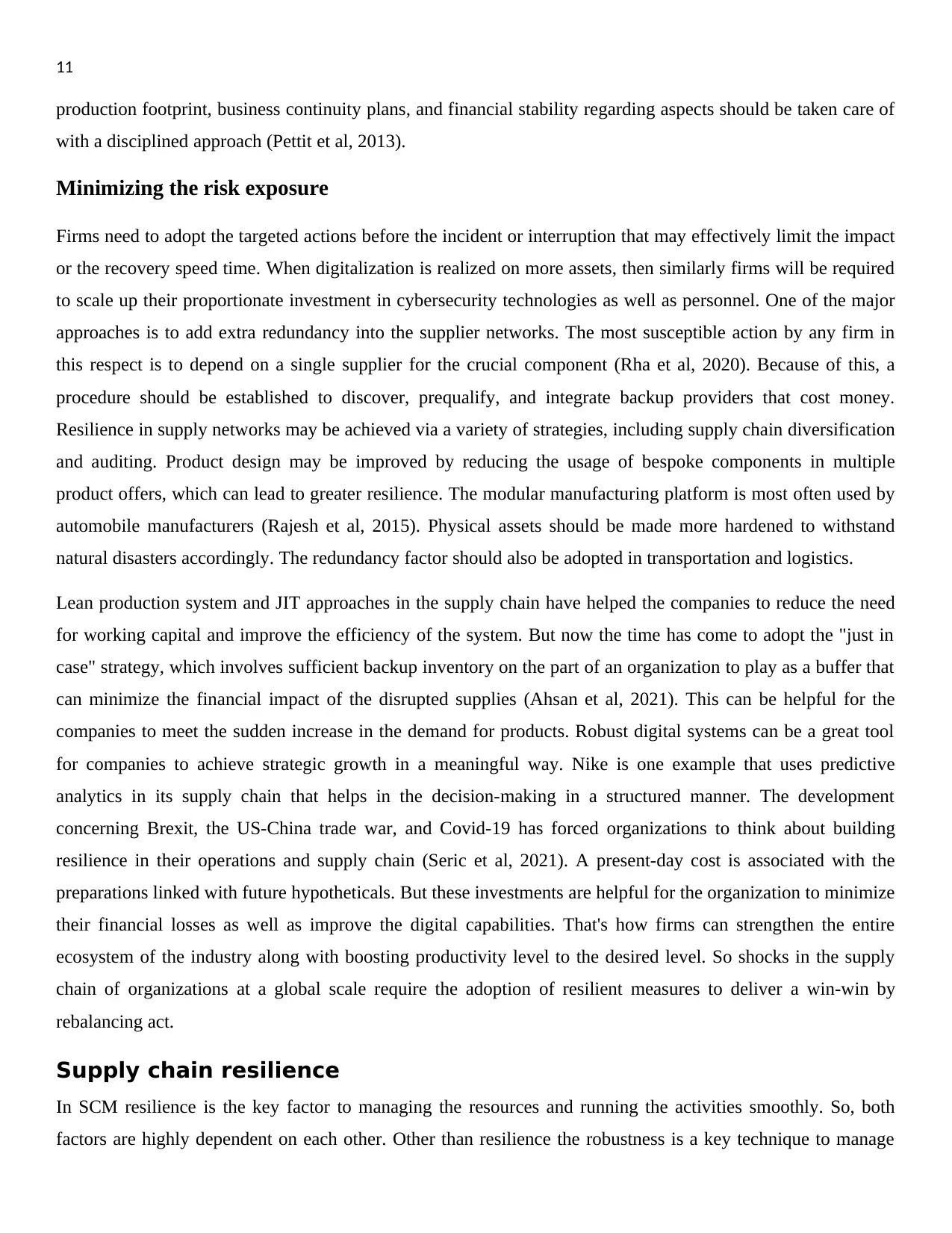
11
production footprint, business continuity plans, and financial stability regarding aspects should be taken care of
with a disciplined approach (Pettit et al, 2013).
Minimizing the risk exposure
Firms need to adopt the targeted actions before the incident or interruption that may effectively limit the impact
or the recovery speed time. When digitalization is realized on more assets, then similarly firms will be required
to scale up their proportionate investment in cybersecurity technologies as well as personnel. One of the major
approaches is to add extra redundancy into the supplier networks. The most susceptible action by any firm in
this respect is to depend on a single supplier for the crucial component (Rha et al, 2020). Because of this, a
procedure should be established to discover, prequalify, and integrate backup providers that cost money.
Resilience in supply networks may be achieved via a variety of strategies, including supply chain diversification
and auditing. Product design may be improved by reducing the usage of bespoke components in multiple
product offers, which can lead to greater resilience. The modular manufacturing platform is most often used by
automobile manufacturers (Rajesh et al, 2015). Physical assets should be made more hardened to withstand
natural disasters accordingly. The redundancy factor should also be adopted in transportation and logistics.
Lean production system and JIT approaches in the supply chain have helped the companies to reduce the need
for working capital and improve the efficiency of the system. But now the time has come to adopt the "just in
case" strategy, which involves sufficient backup inventory on the part of an organization to play as a buffer that
can minimize the financial impact of the disrupted supplies (Ahsan et al, 2021). This can be helpful for the
companies to meet the sudden increase in the demand for products. Robust digital systems can be a great tool
for companies to achieve strategic growth in a meaningful way. Nike is one example that uses predictive
analytics in its supply chain that helps in the decision-making in a structured manner. The development
concerning Brexit, the US-China trade war, and Covid-19 has forced organizations to think about building
resilience in their operations and supply chain (Seric et al, 2021). A present-day cost is associated with the
preparations linked with future hypotheticals. But these investments are helpful for the organization to minimize
their financial losses as well as improve the digital capabilities. That's how firms can strengthen the entire
ecosystem of the industry along with boosting productivity level to the desired level. So shocks in the supply
chain of organizations at a global scale require the adoption of resilient measures to deliver a win-win by
rebalancing act.
Supply chain resilience
In SCM resilience is the key factor to managing the resources and running the activities smoothly. So, both
factors are highly dependent on each other. Other than resilience the robustness is a key technique to manage
production footprint, business continuity plans, and financial stability regarding aspects should be taken care of
with a disciplined approach (Pettit et al, 2013).
Minimizing the risk exposure
Firms need to adopt the targeted actions before the incident or interruption that may effectively limit the impact
or the recovery speed time. When digitalization is realized on more assets, then similarly firms will be required
to scale up their proportionate investment in cybersecurity technologies as well as personnel. One of the major
approaches is to add extra redundancy into the supplier networks. The most susceptible action by any firm in
this respect is to depend on a single supplier for the crucial component (Rha et al, 2020). Because of this, a
procedure should be established to discover, prequalify, and integrate backup providers that cost money.
Resilience in supply networks may be achieved via a variety of strategies, including supply chain diversification
and auditing. Product design may be improved by reducing the usage of bespoke components in multiple
product offers, which can lead to greater resilience. The modular manufacturing platform is most often used by
automobile manufacturers (Rajesh et al, 2015). Physical assets should be made more hardened to withstand
natural disasters accordingly. The redundancy factor should also be adopted in transportation and logistics.
Lean production system and JIT approaches in the supply chain have helped the companies to reduce the need
for working capital and improve the efficiency of the system. But now the time has come to adopt the "just in
case" strategy, which involves sufficient backup inventory on the part of an organization to play as a buffer that
can minimize the financial impact of the disrupted supplies (Ahsan et al, 2021). This can be helpful for the
companies to meet the sudden increase in the demand for products. Robust digital systems can be a great tool
for companies to achieve strategic growth in a meaningful way. Nike is one example that uses predictive
analytics in its supply chain that helps in the decision-making in a structured manner. The development
concerning Brexit, the US-China trade war, and Covid-19 has forced organizations to think about building
resilience in their operations and supply chain (Seric et al, 2021). A present-day cost is associated with the
preparations linked with future hypotheticals. But these investments are helpful for the organization to minimize
their financial losses as well as improve the digital capabilities. That's how firms can strengthen the entire
ecosystem of the industry along with boosting productivity level to the desired level. So shocks in the supply
chain of organizations at a global scale require the adoption of resilient measures to deliver a win-win by
rebalancing act.
Supply chain resilience
In SCM resilience is the key factor to managing the resources and running the activities smoothly. So, both
factors are highly dependent on each other. Other than resilience the robustness is a key technique to manage
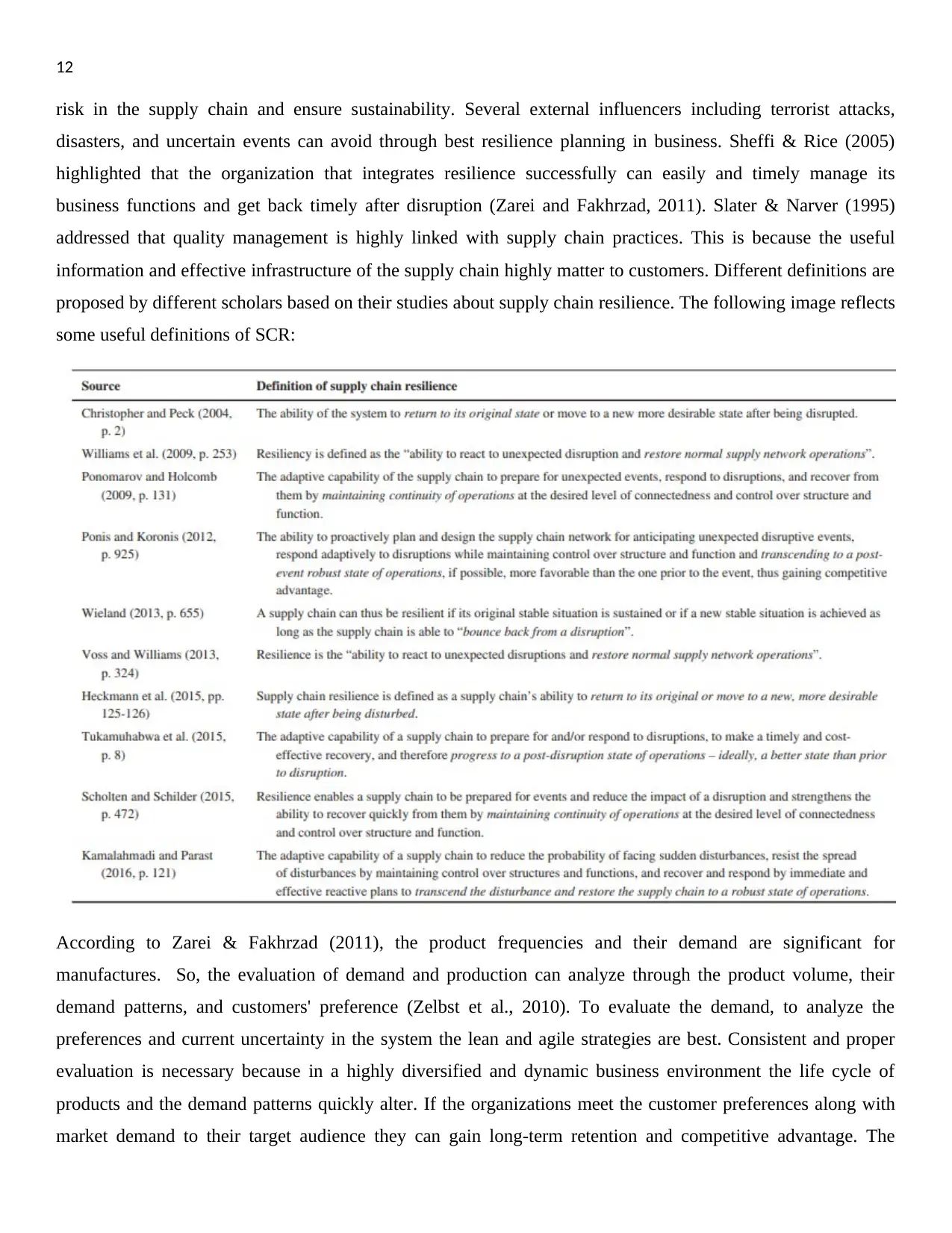
12
risk in the supply chain and ensure sustainability. Several external influencers including terrorist attacks,
disasters, and uncertain events can avoid through best resilience planning in business. Sheffi & Rice (2005)
highlighted that the organization that integrates resilience successfully can easily and timely manage its
business functions and get back timely after disruption (Zarei and Fakhrzad, 2011). Slater & Narver (1995)
addressed that quality management is highly linked with supply chain practices. This is because the useful
information and effective infrastructure of the supply chain highly matter to customers. Different definitions are
proposed by different scholars based on their studies about supply chain resilience. The following image reflects
some useful definitions of SCR:
According to Zarei & Fakhrzad (2011), the product frequencies and their demand are significant for
manufactures. So, the evaluation of demand and production can analyze through the product volume, their
demand patterns, and customers' preference (Zelbst et al., 2010). To evaluate the demand, to analyze the
preferences and current uncertainty in the system the lean and agile strategies are best. Consistent and proper
evaluation is necessary because in a highly diversified and dynamic business environment the life cycle of
products and the demand patterns quickly alter. If the organizations meet the customer preferences along with
market demand to their target audience they can gain long-term retention and competitive advantage. The
risk in the supply chain and ensure sustainability. Several external influencers including terrorist attacks,
disasters, and uncertain events can avoid through best resilience planning in business. Sheffi & Rice (2005)
highlighted that the organization that integrates resilience successfully can easily and timely manage its
business functions and get back timely after disruption (Zarei and Fakhrzad, 2011). Slater & Narver (1995)
addressed that quality management is highly linked with supply chain practices. This is because the useful
information and effective infrastructure of the supply chain highly matter to customers. Different definitions are
proposed by different scholars based on their studies about supply chain resilience. The following image reflects
some useful definitions of SCR:
According to Zarei & Fakhrzad (2011), the product frequencies and their demand are significant for
manufactures. So, the evaluation of demand and production can analyze through the product volume, their
demand patterns, and customers' preference (Zelbst et al., 2010). To evaluate the demand, to analyze the
preferences and current uncertainty in the system the lean and agile strategies are best. Consistent and proper
evaluation is necessary because in a highly diversified and dynamic business environment the life cycle of
products and the demand patterns quickly alter. If the organizations meet the customer preferences along with
market demand to their target audience they can gain long-term retention and competitive advantage. The
⊘ This is a preview!⊘
Do you want full access?
Subscribe today to unlock all pages.

Trusted by 1+ million students worldwide
1 out of 21
Related Documents
Your All-in-One AI-Powered Toolkit for Academic Success.
+13062052269
info@desklib.com
Available 24*7 on WhatsApp / Email
![[object Object]](/_next/static/media/star-bottom.7253800d.svg)
Unlock your academic potential
Copyright © 2020–2025 A2Z Services. All Rights Reserved. Developed and managed by ZUCOL.





